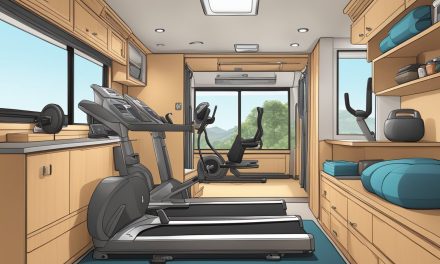Would you like to save this article?
You might wonder if your RV can run without a converter, especially if you want to simplify your setup or avoid a repair. Yes, you can technically use your RV without a converter, but it comes with limits and extra challenges.
Without it, your batteries won’t recharge from shore power, and many 12-volt systems will depend only on stored battery energy.
This means you’ll need to be careful with how you power essentials like lights, water pumps, and fans. Larger appliances that rely on 120-volt power won’t work unless you use other equipment, such as a generator or inverter.
Skipping the converter doesn’t make your RV useless, but it does require more planning and attention to your power supply.
If you want to know how this choice affects your appliances, battery life, and overall comfort, it’s worth looking at the trade-offs before deciding. Understanding what the converter does and how to manage power without it will help you avoid surprises and keep your setup safe.
Key Takeaways
- A converter changes shore power into battery power for your RV systems
- You can run an RV without one, but with limits and more risks
- Smart power management helps you avoid problems when going converter-free
Understanding the RV Converter
Your RV converter plays a direct role in how your electrical system functions. It manages the flow of power between shore power or a generator and your RV’s 12-volt systems, while also keeping your batteries charged and ready.
Knowing how it works helps you avoid power issues and make better decisions about upgrades or replacements.
What Does an RV Converter Do?
An RV converter changes 120-volt AC power from shore power or a generator into 12-volt DC power. This is important because most of your RV systems, like lights, fans, and water pumps, run on DC power.
Without this conversion, those systems would not operate properly when you are plugged into external power.
The converter also charges your RV battery when you are connected to AC power. Instead of letting your battery slowly drain, the converter ensures it stays charged and ready for times when you are not plugged in.
Types of RV Converters
Converters come in different designs, and the type you have affects charging efficiency and battery life.
- Single-Stage Converters: Provide one constant voltage. They are simple but can overcharge or undercharge batteries over time.
- Multi-Stage Converters: Adjust voltage in stages (bulk, absorption, float). This method is safer for batteries and extends their lifespan.
- Smart Converters: Use microprocessors to monitor battery condition and adjust charging automatically. These are the most efficient but also cost more.
If you spend a lot of time off-grid or rely heavily on your RV battery, upgrading to a multi-stage or smart converter can reduce maintenance and replacement costs.
AC to DC Power Conversion
The main job of the converter is AC to DC power conversion. Shore power or a generator supplies 120-volt AC, but your RV’s 12-volt systems cannot use that directly.
The converter steps the voltage down and changes it into DC so your lights, furnace, and water pump can run safely.
This process also keeps your RV battery charged. When AC power flows in, the converter diverts part of that energy into charging the battery while still powering your DC systems.
Without this conversion, you would need separate equipment like a battery charger or solar system to manage your DC needs.
The converter makes this process seamless, so you can plug in and have both AC and DC systems available at the same time.
Can You Operate an RV Without a Converter?
You can run an RV without a converter in certain situations, but how well it works depends on your power source and what systems you need to use.
Some equipment can function normally, while others may not operate at all without the converter in place.
Direct Use of Shore Power
If you stay plugged into shore power, your RV can still run most of its systems without a converter. Shore power provides 120V AC electricity, which is what household outlets and many RV appliances use.
However, many RV features such as lights, fans, and the water pump run on 12V DC power. Without a converter, these systems cannot use shore power directly.
Some RVs may bypass this by depending on a battery to supply 12V needs, but if no converter is present, the battery will not get recharged from shore power.
This means you can operate items like the microwave, air conditioner, and outlets, but your 12V systems may stop working once the battery drains.
For short-term use, this might not be a problem, but for longer stays, it becomes limiting.
Running on Battery Power Alone
You can also operate your RV using only the RV battery as the power source. This works for basic 12V systems such as lights, fans, and the water pump.
The battery provides steady DC power, so these functions should work as expected.
The problem is that batteries have limited capacity. Without a converter or another charging method, the battery will eventually discharge.
Once that happens, your 12V systems shut down.
To extend use, you would need an alternative charging option such as solar panels, a generator, or an external battery charger. These methods can keep the battery topped up, but they require extra equipment and planning.
Limitations Without a Converter
Operating without a converter creates several drawbacks. First, you lose the ability to automatically recharge your RV battery when plugged into shore power.
This means constant monitoring of battery levels.
Second, some RV systems rely on both AC and DC power. For example, slide-outs or leveling jacks may not work properly without a healthy battery.
Even if shore power is available, the lack of a converter makes these systems unreliable.
Finally, running without a converter can shorten battery life. Deep discharges happen more often when no charging system is in place, which wears the battery down faster.
For long-term use, this setup is not practical unless you add other charging solutions.
Power Sources for Your RV
Your RV can draw electricity from several power sources, each with its own benefits and limits.
The right choice depends on whether you are plugged in at a campground, parked off-grid, or balancing both short-term and long-term energy needs.
Shore Power as a Primary Source
Shore power is the most common way to supply electricity to your RV. When you plug into a campground pedestal, you usually connect to either a 30-amp or 50-amp service.
This provides steady 120-volt AC power for large appliances like air conditioners, microwaves, and televisions.
Without a converter, shore power cannot directly charge your RV battery or run 12-volt systems. That means lights, water pumps, and furnace fans may not function unless you have another way to support them.
You should check whether your RV setup allows AC-only operation or requires a converter for DC loads.
Shore power is reliable and convenient, but it ties you to locations with hookups. If you plan to camp in developed parks, this option is usually the easiest and least complicated way to meet your energy needs.
Using Solar Panels
Solar panels give you the ability to recharge your RV batteries without depending on hookups. Panels mounted on the roof or placed on the ground capture sunlight and send it through a charge controller to your battery bank.
This setup works best for 12-volt systems such as lights, fans, and water pumps.
To run 120-volt appliances, you also need an inverter. The inverter converts the stored DC power into AC power, letting you use outlets for small electronics or even some larger devices if your system is sized correctly.
The main limits are weather and panel size. Cloudy days reduce output, and shaded campsites can make solar less effective.
Still, with enough panels and good batteries, you can extend your time off-grid without running out of power.
Generator Alternatives
A portable generator is another option when you do not have shore power. Generators produce 120-volt AC power that can run heavy appliances and, with the right setup, recharge your batteries.
Many RVers use inverter generators because they are quieter and provide cleaner power for electronics.
Fuel use and noise are the main drawbacks. You must carry gasoline or propane, and some campgrounds restrict generator hours.
For short stays or when you need to run air conditioning, a generator can be a practical backup.
Some RV owners combine a generator with solar panels. This lets you rely on solar most of the time and use the generator only when battery levels drop, reducing fuel use while keeping power available.
Impact on RV Appliances and Electrical Systems
Without a working converter, your RV’s electrical setup changes in important ways. You may still power certain items, but the balance between AC power and DC power becomes harder to maintain, which can affect both performance and long-term reliability.
12V Systems and Appliance Functionality
Many RV appliances and fixtures rely on 12V DC power. These include interior and exterior lights, water pumps, furnace blowers, and control boards in refrigerators or water heaters.
Without a converter, these systems must run directly off your house battery. This means your battery will drain faster, especially if several 12V items operate at once.
A single night of using lights, the furnace, and the water pump can leave your battery low.
A converter normally keeps your battery charged when you’re plugged into shore power or a generator. Without it, you’ll need to recharge the battery manually with an external charger or by running the engine.
If your battery voltage drops too far, appliances may fail to start or shut down unexpectedly. For example, a furnace blower may not run long enough to ignite the burner, and lights may dim or flicker.
Voltage Stability and Sensitive Devices
Your RV uses both 120V AC power and 12V DC power, and many devices depend on steady voltage. A converter helps regulate this balance by converting AC to DC and charging the battery at proper levels.
If you skip the converter, voltage can fluctuate. Sensitive electronics such as circuit boards in refrigerators, thermostats, or entertainment systems may not handle these swings well.
Older “dumb” chargers or no charger at all can also risk overcharging or undercharging your battery. Both situations shorten battery life and reduce reliability of connected appliances.
Using only shore power without a converter may still run outlets and large AC appliances like microwaves. However, your DC systems will remain unprotected and unstable, which can cause long-term wear on equipment.
Risks and Challenges of Skipping the Converter
Without a working RV converter, you depend only on your battery and other charging methods. This can create problems with both the safety of your electrical system and the reliability of your power supply.
Potential Damage to Electrical Components
Your RV converter changes 120-volt AC power from shore power or a generator into 12-volt DC power. Without this step, your battery may not charge correctly, and your 12-volt appliances may run inconsistently.
If your battery is allowed to drain too low, it can suffer permanent damage. Lead-acid batteries are especially vulnerable to deep discharge, while lithium batteries may shut down to protect themselves.
Either way, you risk shortening the lifespan of your battery.
Improper charging methods, such as plugging directly into a battery charger not designed for RV use, can also create issues. Overcharging may cause overheating and reduced battery performance.
Undercharging can leave you without enough stored energy for lights, pumps, or fans.
Even small appliances like LED lights or control boards in your fridge rely on stable 12-volt power. If the power source fluctuates, sensitive electronics may fail, leading to costly repairs.
Power Outage Vulnerabilities
Running without a converter means you cannot recharge your battery from shore power. Once your battery drains, your 12-volt systems—such as water pumps, furnace fans, and interior lighting—stop working.
High-demand appliances like microwaves or air conditioners require 120-volt AC power. Without a converter paired with an inverter, you cannot use them unless you connect a generator or special setup.
You also face limits on how long you can camp off-grid. A single battery may only last a day or two if you use multiple devices.
Without solar panels or a generator, you may run out of power quickly. This leaves you without refrigeration, heating, or even basic lighting.
Best Practices for RV Power Management
Managing power in your RV comes down to taking care of your battery and selecting the right mix of charging methods. Good habits and smart equipment choices help you avoid dead batteries, wasted fuel, and unnecessary wear on your system.
Maintaining Your RV Battery
Your RV battery is the foundation of your electrical system. Without steady power storage, even efficient setups fall short.
Regular checks and proper charging extend battery life and reduce the risk of failure when you need it most. Keep the terminals clean and free of corrosion.
A wire brush and protective spray can prevent buildup that interrupts current flow. Inspect cables for cracks or loose connections, as even small issues can cause voltage drops.
Avoid draining your battery below 50% if you use lead-acid. Deep discharges shorten lifespan and reduce performance.
Lithium batteries handle deeper discharges but still benefit from consistent monitoring. Use a battery monitor to track voltage and state of charge.
Many models connect to your phone, giving you real-time updates. This helps you adjust usage before power drops too low.
Store your battery properly during long breaks. A trickle charger or solar panel with a charge controller can maintain a steady level without overcharging.
Choosing the Right Power Setup
Your power setup should match how and where you camp. If you stay at campgrounds with hookups, a converter and shore power may be enough.
If you prefer boondocking, you’ll need a more flexible system.
Common options include:
- Solar panels for renewable charging during the day
- Portable generators for backup power
- Inverters to run small AC appliances from DC power
Solar panels paired with a charge controller provide quiet, reliable charging. A 200–400 watt setup can cover lights, fans, and device charging.
Larger arrays support refrigerators and other steady loads. Generators supply higher wattage for short bursts, but they use fuel and create noise.
Using them mainly for battery charging reduces run time and fuel costs. Combining solar with upgraded deep-cycle or lithium batteries gives you longer off-grid capability.





